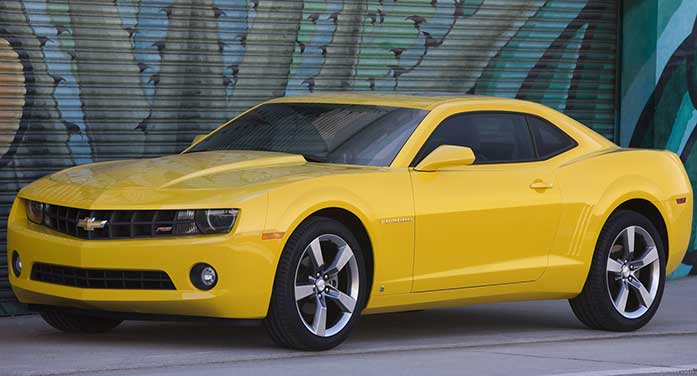 Introduced in 2009 and manufactured in Oshawa Ont., the fifth-generation Chevrolet Camaro banked heavily on baby-boomer nostalgia.
Introduced in 2009 and manufactured in Oshawa Ont., the fifth-generation Chevrolet Camaro banked heavily on baby-boomer nostalgia.
And aside from the fact that it delivered better fuel economy than its predecessors, had better handling and braking, and was more environmentally correct, the driving experience was much the same.
This generation of the Camaro was based on the same platform as the defunct Pontiac G8 and took much of its engineering from the Holden Commodore, which was sold in Australia.
In 2011, there were five basic versions, three with a V6 engine and two with V8s. The pavement-scalder of the bunch was the SS, which came with a 6.2-litre V8 taken from the Corvette, mated to a six-speed manual transmission or automatic gearbox. This engine could take the SS from zero to 60 km/h in about five seconds. It required premium gas.
The six-speed manual transmission/V8 combo had a slick gearshift override. During low engine revs, it automatically shifted from first to fourth in an effort to cut down on gas consumption. Given the substantial torque output of this engine, the transition was handled effortlessly by the drivetrain, and this feature only came into play below 30 km/h. It was similar to a system found in some models of the Corvette.
The automatic six-speed featured GM’s Active Fuel Management system, which shut off half the cylinders under light load for improved fuel economy. Again, it’s an almost seamless transition.
Some felt the styling of the new Camaro was too angular and rough around the edges, but it does convey the requisite muscularity and bad boy persona, with a dash of nostalgia thrown in for good measure.

This version of the Camaro conveys the requisite muscularity and bad boy persona, with a dash of nostalgia thrown in for good measure
The SS model, in particular, is an unapologetic high-performance automobile aimed at buyers who like to drive with enthusiasm and want everyone to know it. You could also order a special Rally Yellow paint, which made the Camaro a bit a ticket magnet.
 Because of its low roofline and small windows, rear visibility while backing up is restrictive. The new Camaro has turned out to be one of the most challenging vehicles on the market when it comes to parallel parking.
Because of its low roofline and small windows, rear visibility while backing up is restrictive. The new Camaro has turned out to be one of the most challenging vehicles on the market when it comes to parallel parking.
As well, the manual transmission features a long throw between gears, with a heavy linkage action. The whole driving experience of this Camaro is pure 1960s pony car.
A convertible version was also offered this year, with many of the same characteristics.
There was only one safety recall to report from Transport Canada. Apparently, with some of the V8 models, the positive cable from the battery could chafe against the starting motor, eventually short out and possibly cause an engine stall or, worse, a fire. This is easily fixed: dealers simply rerouted the cable.
There were, however, a rather hefty 71 technical service bulletins on file with the U.S.-based National Highway Traffic Safety Administration (NHTSA). They covered just about everything from possibly leaky automatic transmissions, to shifting problems with the manual gearbox, to a glitchy fuel gauge, to a “slight engine misfire.”
This version of the Camaro got mixed grades from Consumer Reports. While there were no glaring problem spots, and most areas of the car garnered above-average marks, CR nonetheless gave this year of the revised Camaro an “average” used car predictability rating.
Lots of comments from owners, including:
- “Consumer Reports got this one wrong”;
- “trunk opening too small”;
- “MP3 player quit working on first major road trip”;
- “gauges could have been nicer”.
Lack of back seat elbow room and poor peripheral visibility were common gripes. Issues with the transmissions and software gremlins seemed to be prevalent, as did complaints about fuel economy. Whether you chose the V6 or V8 models, this Camaro could in no way be classed as a fuel-sipper.
From a $27,000 base price, the 2011 Camaro has held its value reasonably well, with the base LS model now in the high teens, while a loaded SS with the big V8 is approaching the $30,000 range.
2011 Chevrolet Camaro
Original base price: $26,995
Engine: 3.6-litre V6 or 6.2-litre V8
Horsepower: 312 or 426
Torque: 273 foot pounds or 420 foot pounds
Transmission: six-speed automatic or six-speed manual
Fuel economy (litres/100 km): 11.4 city and 6.9 highway (V6 with automatic transmission), with regular or premium gas
Drive: rear-wheel
Alternatives: Dodge Challenger, Ford Mustang
Ted Laturnus has been an automotive journalist since 1976. He was named Canadian Automobile Journalist of the Year twice and is past president of the Automobile Journalists Association of Canada (AJAC). For interview requests, click here.
The views, opinions and positions expressed by columnists and contributors are the authors’ alone. They do not inherently or expressly reflect the views, opinions and/or positions of our publication.
© Troy Media
Troy Media is an editorial content provider to media outlets and its own hosted community news outlets across Canada.

